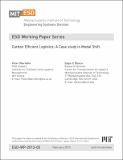| dc.description.abstract | Corporate sustainability is becoming increasingly important in the development of business strategies. Consequently, transport and logistics operations come under particular scrutiny due to their substantial impact on the environment. The aim of this paper is to illustrate two successful examples where logistics performance is optimized in tandem with a reduction in carbon emission. The selected case study provides documented examples, detailing how GHG reductions can be achieved while improving business efficiency. The following two initiatives of an US company of the paper and packaging producing sector will be presented:
Initiative I:
The company works closely with their customers to promote rail transport.
Goods are directly sent from production plants which operate their own railway connection to the customer that is also located along the railway.
In 2011, the promotion of rail transport on 4 US routes saved 62–72% CO[subscript 2] emission (1,500-2,300 tons of CO[subscript 2]) compared to trucking. These savings are equivalent to taking 300-450 cars off the road every year.
Initiative II:
The company uses space-efficient pallets in selected railcars and thereby increases the number of shipped goods.
Besides optimizing the spatial utilization of the cars, CO[subscript 2] can be saved by transporting more goods on the same railcar.
190 tons of CO[subscript 2] were saved by using space-efficient pallets in 930 railcars in 2011. This equals the CO[subscript 2] emission caused by 21,637 gallons of gasoline consumed by road vehicles.
The case study calculations illustrate, step-by-step, how the reductions were estimated, and provide a detailed “road map” for future participants to implement and properly estimate the GHG reductions. Additionally, we also aim to present ‘Carbon Footprinting’ as a useful method of environmental monitoring and reporting and discuss different methodological approaches. | en_US |

